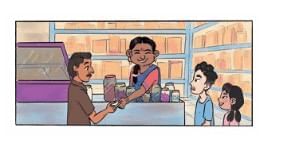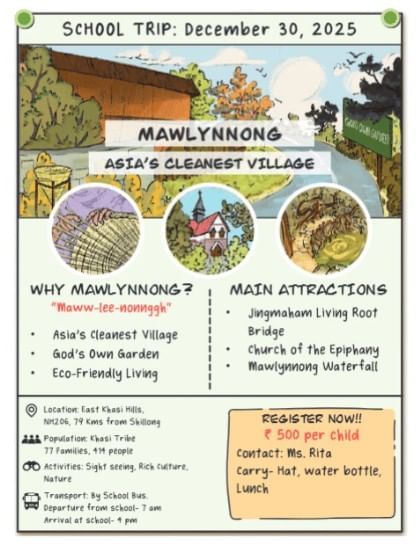Unit Test (Solutions): The Cleanest Village | Mathematics for Class 4 (Maths Mela: New NCERT) PDF Download
Total Marks: 20
Attempt all questions.
- Question numbers 1 to 4 carry 1 mark each.
- Question numbers 5 to 9 carry 2 marks each.
- Question numbers 10 to 11 carry 3 marks each.
Q1. If a notebook costs ₹25, what is the cost of 2 notebooks? (1 Mark)
a) ₹25
b) ₹50
c) ₹75
d) ₹100
Ans: b) ₹50
2 × ₹25 = ₹50
Q2. If you pay ₹100 for an item costing ₹60, what is the balance? (1 Mark)
a) ₹40
b) ₹60
c) ₹100
d) ₹160
Ans: a) ₹40
₹100 − ₹60 = ₹40
Q3. If a water bottle costs ₹15, how much do 3 water bottles cost? (1 Mark)
a) ₹15
b) ₹30
c) ₹45
d) ₹60
Ans: c) ₹45
3 × ₹15 = ₹45
Q4. If Daisy buys items for ₹80 and ₹45, what is the total cost? (1 Mark)
a) ₹80
b) ₹45
c) ₹125
d) ₹135
Ans: c) ₹125
₹80 + ₹45 = ₹125
Q5. Calculate the total cost of 2 pencils at ₹10 each and 1 bag at ₹90. (2 Marks)
Ans:
Cost of 2 pencils = 2 × ₹10 = ₹20
Cost of 1 bag = ₹90
Total cost = ₹20 + ₹90 = ₹110
Total cost = ₹110
Q6. Lou pays ₹150 for items costing ₹110 at Udaya Didi’s store. How much balance does he get back? (2 Marks)
 Ans:
Ans:
Money paid = ₹150
Cost of items = ₹110
Balance = ₹150 − ₹110 = ₹40
Balance = ₹40
Q7. Find the total cost of 4 bus tickets at ₹50 each and 1 guidebook at ₹30. (2 Marks)
Ans:
Cost of 4 bus tickets = 4 × ₹50 = ₹200
Cost of 1 guidebook = ₹30
Total cost = ₹200 + ₹30 = ₹230
Total cost = ₹230
Q8. Krishna buys 3 packets of biscuits at ₹20 each and pays ₹100. How much balance does he get back? (2 Marks)
Ans:
Cost of 3 packets = 3 × ₹20 = ₹60
Money paid = ₹100
Balance = ₹100 − ₹60 = ₹40
Balance = ₹40
Q9. One school sends 24 teachers, and another sends 28 teachers for the Mawlynnong trip. How many teachers are going in total? (2 Marks)

Ans:
Teachers from first school = 24
Teachers from second school = 28
Total teachers = 24 + 28 = 52
Total teachers = 52
Q10. Calculate the total cost of 2 notebooks at ₹25 each, 1 pen at ₹15, and 1 water bottle at ₹30. (3 Marks)
Ans:
Cost of 2 notebooks = 2 × ₹25 = ₹50
Cost of 1 pen = ₹15
Cost of 1 water bottle = ₹30
Total cost = ₹50 + ₹15 + ₹30 = ₹95
Q11. Daisy and Lou have ₹300 in total for shopping. They spend ₹175 on gifts and food. How much money is left with them? (3 Marks)
Ans:
Total money = ₹300
Money spent = ₹175
Money left = ₹300 − ₹175 = ₹125
Money left = ₹125
|
54 videos|186 docs|14 tests
|
FAQs on Unit Test (Solutions): The Cleanest Village - Mathematics for Class 4 (Maths Mela: New NCERT)
| 1. What are the key features that contribute to a village being considered the cleanest? |  |
| 2. How can villages promote cleanliness among their residents? |  |
| 3. What role do government initiatives play in maintaining cleanliness in villages? |  |
| 4. Why is cleanliness important for a village's overall development? |  |
| 5. How can schools contribute to promoting cleanliness in villages? |  |
















